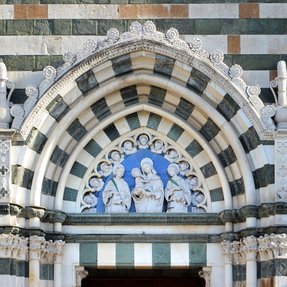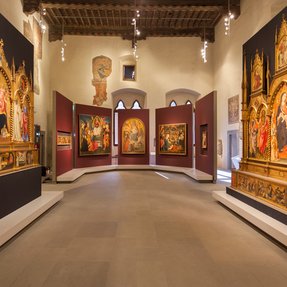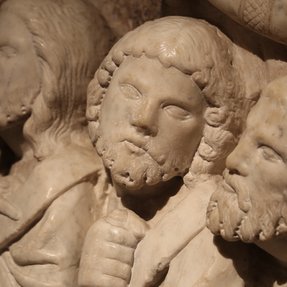
Discovering the Lippi
Prato, in the fifteenth century, played a crucial role in the history of art, giving rise to memorable undertakings that scattered the early Renaissance. The heart of the city houses a unique treasure of the works by Fra Filippo Lippi, one of the great masters of that period. The exciting artistic journey includes a rich series of panel paintings and wonderful frescoes in the Cathedral, offering a fascinating journey into the art of this controversial artist. Even more precious are the testimonies of his famous son, Filippino, also a renowned painter, born in Prato from the famous relationship between the friar and the nun Lucrezia Buti.
The story of Lucrezia and Filippo, scandalous for the time, has come down to us through Vasari: Fra Filippo Lippi met Lucrezia Buti, a nun in the monastery of Santa Caterina, in 1456, while working on the panel of the Madonna giving the Girdle to Saint Thomas and immediately fell in love with her. He wanted her to be his model for the painting at all costs. Regardless of their religious condition, during the procession of the Sacred Belt, Filippo kidnapped Lucrezia, as told by Vasari: "And on this occasion (of the painting) falling more in love with her, he did everything to led her away from the nuns and kidnap her exactly on the day she went to see the display of the Sacred Belt of the Madonna (Life of Fra' Filippo Lippi).
From their relationship two children were born, Filippino and Alessandra. Although the couple obtained a dispensation from their vows from Pius II, thanks to the intervention of Cosimo de' Medici, they decided not to marry, an act which amplified the scandal.
The fame of this story spread so widely that even the romantic poet Robert Browning and at least two works by Gabriele D'Annunzio, a young student in Prato, were fascinated by it.
“How I enjoyed my morning hours in the Cathedral! Perhaps as for Fra Filippo Lippi, not while he was executing the fresco of the Funeral of St. Stephen, but while he was working on Herod's Banquet, inebriated by Lucrezia Buti. (…) I turned my head back to feed on Salome, to satiate myself with Herodiana, to dissolve honey and wax together even once in my greed. And once again I delighted in the torment of choice. "Which of the two are you, Lucrezia Buti? (...) are you truly more true in the painting of Fra Filippo in the municipal palace, not the Virgin of the Girdle but that sweet Saint who places her hand on the head of a kneeling nun who is certainly Bartolomea de' Bovacchiesi, your abbess of the time of your sin? You are not one but three for my love, Lucrezia Buti" (G. D'Annunzio, The second lover of Lucrezia Buti).
The pictorial cycle of the Stories of Saint Stephen and Saint John the Baptist (1452-65) is preserved in the Cathedral. On the left wall of the main chapel there are scenes relating to Saint Stephen, patron saint of Prato. Among the fascinating scenes, there is the funeral after the discovery of Stephen's body, where it is possible to identify the figure of Pope Pius II on the right flanked by two friars; the older one, on the right, could be a self-portrait by Lippi.
On the opposite wall, dedicated to Saint John the Baptist, the lower scene shows Herod's Banquet, with Salome's dance, the decapitation of the Baptist and a luminous Salome (for whom Buti was the model) offering John's head to Herodias, his mother. The dancing figure of Salome is undoubtedly one of the icons of Prato art!
Filippo remained in Prato until 1467, leaving other extraordinary works such as the three splendid altarpieces preserved in the Palazzo Pretorio: the Madonna del Ceppo, created for the Datini Palace, the Madonna of the Girdle, painted for the Monastery of Santa Margherita, where Filippo met Lucrezia Buti, and the Nativity for the Convent of San Domenico.
In town you can admire two other works by Filippo: the Transit of Saint Jerome, today in the Cathedral Museum, and the Presentation in the Temple in the Church of the Spirito Santo. By Filippino, however, a Crucifix, the Mercatale Tabernacle and a touching Madonna and Child are preserved in Palazzo Pretorio.
Information note: the itinerary can be easily done on foot as it is all in the historic centre.
Information
-

Involved Municipalities: Prato








